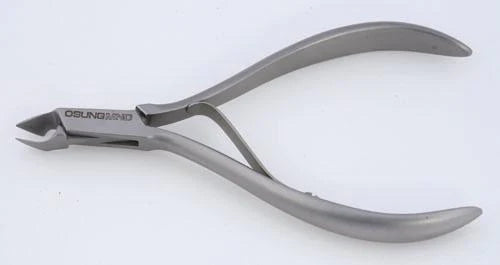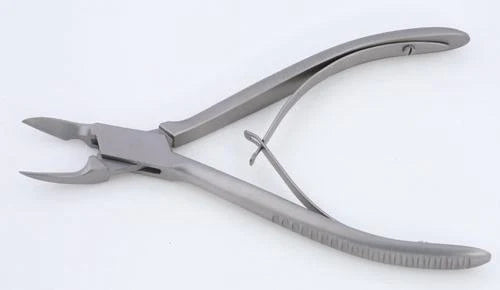Dental bone and soft tissue nippers are an essential tool for the dentist. They allow us to quickly and easily remove bone and soft tissue from teeth during extractions, root canals, and other procedures. Bone nippers have a sharp blade that is used to cut through bone, while soft tissue nippers have a blunt blade that is used to cut through softer tissues such as skin or muscles.There are a variety of different models available, so it is important to select the right one for your needs.
Types of dental bone and soft tissue Nippers:
-
Bone & Soft Tissue Nipper, Cohen 100mm, TNC100.
-
Bone & Soft Tissue Nipper, Cleveland, 165mm.
Bone & Soft Tissue Nipper, Cohen 100mm, TNC100:
Bone and soft tissue nippers are invaluable tools for any dentist. The Cohen 100mm TNC100 is a great option for anyone looking for an affordable, high-quality nipper. This tool is made of durable stainless steel and has a comfortable grip that makes it easy to use. It's perfect for precision cutting, making it ideal for a variety of dental procedures.
Bone & Soft Tissue Nipper, Cleveland, 165mm:
The Bone & Soft Tissue Nipper, Cleveland, 165mm is a great tool for dentists. With its sharp blades and durability, this nipper can easily cut through bone and soft tissue. It's also easy to use, making it perfect for any dentist. Whether you're a beginner or experienced user, this nipper is sure to provide the results you're looking for. So if you're in need of a quality bone and soft tissue nipper, the Bone & Soft Tissue Nipper, Cleveland, 165mm is your best option.
Components of dental bone and soft tissue Nippers:
Components of dental bone and soft tissue nippers are given below:
- Blade
- Handle
What are the main benefits of using a dental bone and soft tissue Nippers?
There are a few key benefits to using dental bone and soft tissue nippers:
- They offer precision cutting: This allows for more delicate and complex procedures to be carried out, which would otherwise be difficult or impossible to do with other tools.
- They cause less trauma to the surrounding tissues: This is because they create small cuts instead of large ones, which means there is less damage and healing time is reduced.
- They can be used in tight spaces: This makes them ideal for working in areas that are difficult to reach with other instruments.
- They can also help improve the appearance of your smile by providing a more even, symmetrical look.
Why are dental bone and soft tissue Nippers effective?
Dental bone and soft tissue Nippers are effective because they have a sharp, pointed edge that can cut through dental bone and soft tissue. They are also angled so that they can easily reach into tight spaces, which makes them ideal for removing dental bone and soft tissue. Additionally, the handles on Nippers are curved so that they fit comfortably in the user's hand, which allows for greater precision when cutting.
What are the main uses of dental bone and soft tissue Nippers?
Dental nippers are hand-held instruments that are used to remove excess dental material, such as tooth structure or soft tissue. There are two types of dental nippers: bone nippers and soft tissue nippers. Bone nippers are designed to remove excess bone, and they have sharp, serrated jaws that can easily cut through bone tissue. Soft tissue nippers, on the other hand, have blunt jaws that are designed to cut through soft tissue, such as gingiva or mucosa. Dental nippers are generally used during dental procedures, such as tooth extractions or dental implant placement. In most cases, dental nippers are used to remove small amounts of dental material; however, they can also be used to create larger defects in the jawbone or soft tissue.
What are the precautions we need to take while using the dental bone and soft tissue Nippers?
Precautions we need to take while using the dental bone and soft tissue Nippers are given below:
- Always use a mirror and ensure good visibility of the target area before beginning surgery.
- Make sure that the nippers are in good condition and free of any rust or sharp edges.
- Do not use excessive force when cutting through bone or soft tissue as this can easily result in damage to the surrounding area.
- Finally, always disinfect the nippers before and after use.
- Keep out of reach of children when not in use.
What types of patients would benefit from using dental bone and soft tissue Nippers?
There are a number of different types of patients who could benefit from using dental bone and soft tissue Nippers, including those who have recently had oral surgery, those who have periodontal disease, and those who need to remove excess bone or soft tissue from their teeth. Nippers are also a great choice for those who need to perform precision work on their teeth, such as removing small bits of calculus or plaque. They can also be used to trim and contour gums, making them an essential tool for achieving perfect oral health.
What factors should be noted while choosing a dental bone and soft tissue Nippers?
When choosing a dental bone and soft tissue Nipper, there are several points to consider. First, the size and shape of the jaws should be appropriate for the application. Second, the Nippers should be calibrated so that they deliver a consistent amount of force with each cut. Third, the cutting edges should be sharp and free of nicks or burrs. Finally, the overall construction should be rugged and durable enough to withstand repeated use.
What is the working of the dental bone and soft tissue Nippers?
The working of the dental bone and soft tissue Nippers is very simple. This instrument is basically a pair of forceps that have been modified to include a small cutting blade at the tips. The blades are sharpened in such a way that they can easily cut through bone and soft tissue without causing much damage to the surrounding tissue. To use this instrument, the dentist simply needs to insert the tips of the forceps into the mouth and then squeeze them together. This action will cause the blades to come into contact with each other, resulting in a clean cut. In most cases, the dental bone and soft tissue Nippers can be used with one hand, making it a very efficient tool for dentists.
Why do we choose the dental bone and soft tissue Nippers?
There are a few reasons why we might choose dental bone and soft tissue nippers. One reason is that they have a long reach and can easily access hard-to-reach areas of the mouth. They're also great for cutting through tough or fibrous tissue, making them ideal for removing impacted wisdom teeth or other difficult-to-remove tissues. Lastly, they're very precise instruments which makes them perfect for delicate surgical procedures.
When should the dental bone and soft tissue Nippers be replaced?
The dental bone and soft tissue Nippers should be replaced when they become dull or damaged. Depending on how often they are used, they may need to be replaced every few months. To prolong their life, it is important to clean and sharpen them regularly. If the blades are damaged, they can cause injuries to the mouth or gums. If they are not properly sharpened, they will not cut easily.
Review:
Dental bone and soft tissue nippers are tools used by dentists to cut off excess bone or soft tissue during a dental procedure. They are a common tool in oral surgery, and come in different shapes and sizes to suit the specific needs of each procedure.Made from stainless steel, dental bone and soft tissue nippers are durable and easy to clean.




